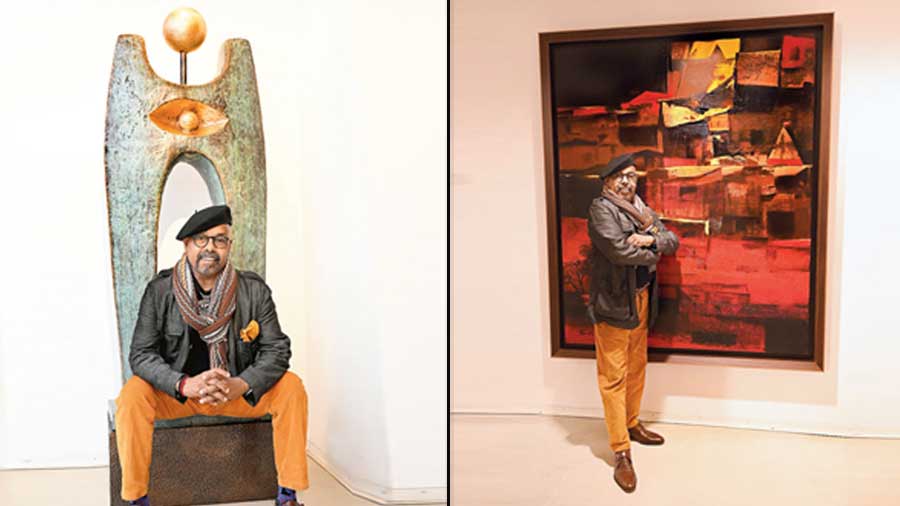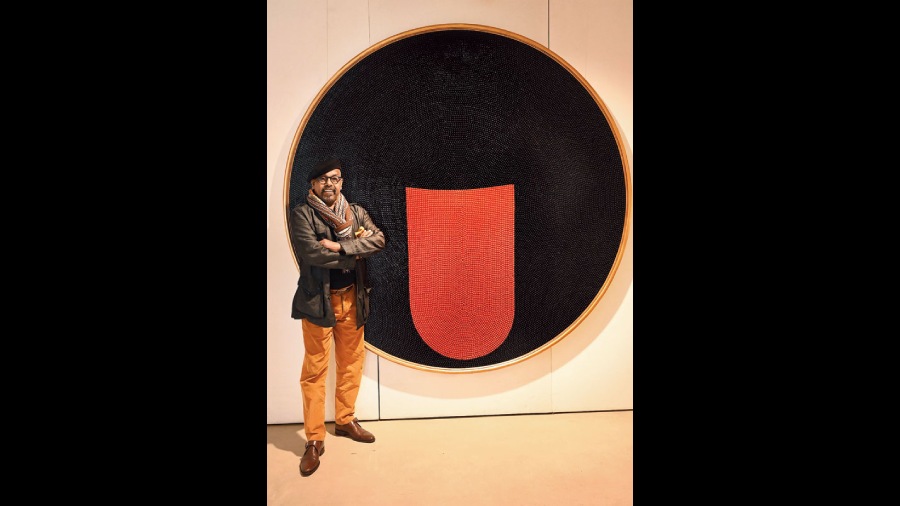If Paresh Maity’s massive retrospective of 120 water colours and sketches resonated in Calcutta exactly a year ago with a mix of his virginal early work and his contemporary waterscapes awash with fervent paintbrush and passion, this time around, it is a multi-genre exhibition of gigantic proportions. “A culmination of years of quest, seeking to capture the essence of nature,” is how Maity sums it up.
It is beyond a quest though, when the viewer comes into the CIMA Gallery exposition Infinite Light: Works by Paresh Maity, which opened formally on December 12 to reveal a larger-than-life-size couple in bronze, 22feet in height, at the entrance. Titled in simplicity as The Pair, yet you find the complex emotive pull depicting a man and woman in harmony and balance, where amour becomes further accentuated with the interplay of light at dusk to reveal a dynamic compulsive connect.
Light and shade, darkness and depth, rich texture and his famous fanciful line drawings, all combine to bring out a luminosity of expression through showcasing four decades of his gargantuan output. His signature sweeping oils and acrylics with their bountiful colour palettes we have come to accept, but what can take you by surprise are the smaller works, intricately teasing out interpretation — a narrowcasting where scope and dimension inclusively portray in miniature the seeing eye, and hovels and ascending stairs disappear into mysterious darkness, the earth colours giving off a subtle light and shade.
Maity himself admits that although he is master of large scale, yet when he realised 32 years back, post graduation, that abstraction was his metier, so the scale of vision, whether large or small, had to parallelly have equal strength. These small works are done in the German impasto technique, where his paints are slapped on thick, and then worked in through his canvases like the one where you see two trees and a figure and huts, or just a village scene, an expression of a face in folk style, yet others capturing his favourite sakaar and nirakar boats that hark back to his Tamluk days.
But it is his favourite stomping ground Varanasi, which he has visited 100 times, that gives him the inspirational heft to depict the eternal city in many moods. Mixing tradition with modernity, the ghat steps and temples and heritage windows are the immortal sirens and then the offbeat flies that come into play in the monsoon, add to the contemporaneity to give a fresh twist to the chiaroscuro effect.
Where Maity’s Varanasi plumbs the depths of the city’s soul to eke out new apparitions, his Venice is more serene, picture perfect, the aquamarine and cerulean shades of sky and water praying to be left in their stasis.
A subtle line drawing of Venice, visited 27 times by him, has a unique limpid light and darkness, that bursts through multidimensionally. And then in another canvas, you see a fishing village from another part of his well-trammeled world in ravishing red that emanates from the hues of the rising sun, a lighthouse rising mysteriously in the midst, and the trawler returning after its successful catch. They encapsulate nature’s infinite light and the love of the artist to capture the mornings that he is so much in sync with from childhood.

But although he is enamoured of the play of light, yet it can be capricious and elude him, until he captures it with colour, that helps not just in the translation into the physical but to study and understand even in abstraction, as he puts it, the “play of luminosity”.
But what gives with the ceramics? They have neither the scale nor depth and tend to make a monochromatic statement. Maity is quick to come to the defence of this art form which makes him humbly hark back to his days of innocent play by the river, communing with clay. As a seven-year-old, working with clayey soil was the most natural thing to do, and it is this that is the germination point, he stresses, of ceramics, where his vases and urns take on a Grecian gait, and his plaques cry out for being adopted into your home. If sculpture goes through many stages, so do ceramics.

Cubism comes to the fore in a powerful moving image of a man and woman riding a horse and being spirited away on a new journey of life — all the while the artist maintaining his play of light and shade. In stark contrast, his minimalism, inspired by Japanese and Chinese art, shows the master artist draw up a woman with a cat; a snake charmer; a conversation. And the Himalayas, the source of the Ganges — the river in multitude cities where he docks, that powerfully becomes a leitmotif of his acrylic and oil appassionata.This is perhaps the biggest solo exhibition by an Indian artist ever, as it has covered four of the major metros over a period of five months and has included paintings on textile for the first time, apart from some films which show the boundless energy of the artist engaged in structural perfection. At CIMA Gallery, the placements of the large sculptural work next to water colour and mixed media on board, some sculptures which “are an index of the mind”, others like the strong woman with a basket that holds itself up; the ebullient canvases — one where the people are in free float, in juxtaposition with drawings and ceramic work have under one roof brought in “a magic realism where life, time, memory, space and form merge to create a mesmeric after-feel,” to quote from gallery director Rakhi Sarkar. And it is only in Calcutta where the very first work captures and holds your spiritual eye with the rendering of Mahakali with black and red glass balls in a circular construct — an artistic-religious abstraction that is of disturbingly magnetic cosmic proportions.
The exhibition is on at CIMA — Centre of International Modern Art — until January 28. Expect Paresh Maity’s presence on occasion. In fact, his omniscience during this period has been full of new surprises. Adding his tonal dimension on canvas to an evening performance of the sarod duo Amaan Ali Bangash and Ayaan Ali Bangash, in the backdrop of the eternal Victoria Memorial in a jugalbandi of art and music.
At the end of the day, there is in Maity’s magnetic appeal a certain quality where the viewer is led to perseverate in reliving the myriad moods, messages and moments that prolong a thought in solitude well after the stimulus that prompted it ceases to exist but continues in the mind’s eye and the sated psyche of the spectator.
The author is a communications professional
